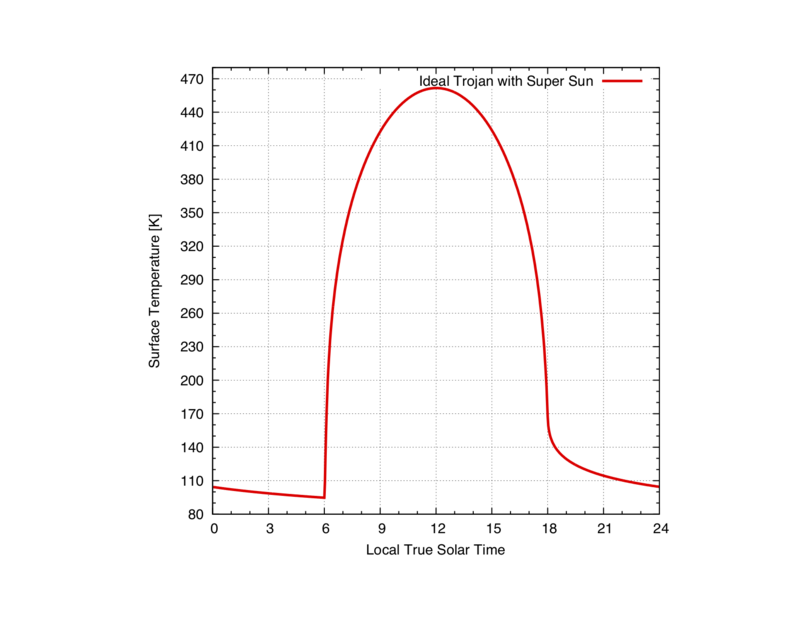KRC for Exoplanets
| Line 30: | Line 30: | ||
Then run generic_porb() with these arguments, for example: | Then run generic_porb() with these arguments, for example: | ||
| − | tmp = generic_porb(e = 0, a = 1., i = 1.3, node = 100.4, peri = 293.9, m = 79.6, rot_per = 200., polera = 273.8, poledec = 0., merid = 7.7, period = 4332.5, name = "IdealJupiterTrojan") | + | tmp = generic_porb(e=0,a=1.,i=1.3,node=100.4,peri=293.9,m=79.6,rot_per=200.,polera=273.8,poledec=0.,merid=7.7, period=4332.5,name="IdealJupiterTrojan") |
Then run KRC using this new body as the "body": | Then run KRC using this new body as the "body": | ||
| − | out = krc( lat = 0., lon = 0, INERTIA = 20., ALBEDO =.05, LKofT = "F", body = tmp) | + | out = krc(lat=0.,lon=0,INERTIA=20.,ALBEDO=.05,LKofT="F",body=tmp) |
This case above assumes the Sun as the central star. Any star can be defined by setting SOLCON (solar constant defined as the total stellar irradiance at 1AU in W/m^2. In the solar system, SOLCON ~ 1,361 W/m2. | This case above assumes the Sun as the central star. Any star can be defined by setting SOLCON (solar constant defined as the total stellar irradiance at 1AU in W/m^2. In the solar system, SOLCON ~ 1,361 W/m2. | ||
| − | out = krc( lat = 0., lon = 0, INERTIA = 20., ALBEDO =.05, LKofT = "F", body = tmp, SOLCON = 2722.) | + | out = krc( lat=0.,lon=0,INERTIA=20.,ALBEDO=.05,LKofT="F",body=tmp,SOLCON=2722.) |
The case above assumes a start outputting twice as much energy as the Sun ("Super Sun"). | The case above assumes a start outputting twice as much energy as the Sun ("Super Sun"). | ||
| − | [[Image:Exoplanets.png| | + | [[Image:Exoplanets.png|800px]] |
Example of Surface temperatures for two airless bodies, one in the solar system, one with identical orbital parameters, but a much warmer Sun. | Example of Surface temperatures for two airless bodies, one in the solar system, one with identical orbital parameters, but a much warmer Sun. | ||
Revision as of 19:41, 1 April 2020
A user can define the orbital parameters of any body rotating around any star. PORB generates the rotation matrix accordingly.
First, run PORB to create a structure that can be ingested to generate the orbital rotation matrix. The following arguments are needed:
- e: Eccentricity (Default=0)
- a: Semi-Major Axis in AU (Default=1)
- i: Inclination of mean orbit to ecliptic in degrees (Default=0)
- node: Longitude of the asceding node in degrees (Default=0)
- per: Argument of perihelion in degrees (Default=0)
- m: Mean Anomaly at epoch in degrees (Default=0)
- rot_per: siderial rotation period in hours (Default=23.9345)
- polera: Right Ascension of the pole in degrees (Default=0)
- merid: Prime meridian at epoch in degrees (Default=0)
- poledec: Declination of the pole in degrees (Default=0)
- period: Sideral orbital period in Earth days (Default=365.256)
- name: Body name (default ="None")
Then run generic_porb() with these arguments, for example:
tmp = generic_porb(e=0,a=1.,i=1.3,node=100.4,peri=293.9,m=79.6,rot_per=200.,polera=273.8,poledec=0.,merid=7.7, period=4332.5,name="IdealJupiterTrojan")
Then run KRC using this new body as the "body":
out = krc(lat=0.,lon=0,INERTIA=20.,ALBEDO=.05,LKofT="F",body=tmp)
This case above assumes the Sun as the central star. Any star can be defined by setting SOLCON (solar constant defined as the total stellar irradiance at 1AU in W/m^2. In the solar system, SOLCON ~ 1,361 W/m2.
out = krc( lat=0.,lon=0,INERTIA=20.,ALBEDO=.05,LKofT="F",body=tmp,SOLCON=2722.)
The case above assumes a start outputting twice as much energy as the Sun ("Super Sun").
Example of Surface temperatures for two airless bodies, one in the solar system, one with identical orbital parameters, but a much warmer Sun.
